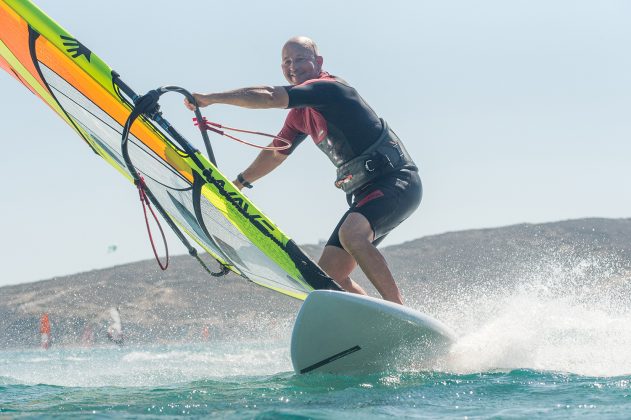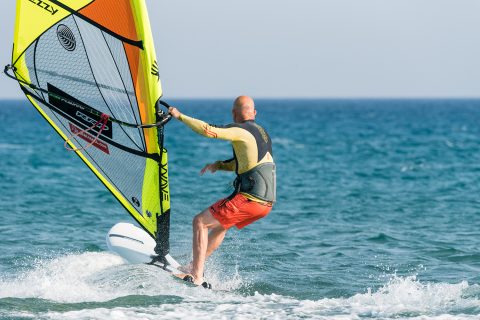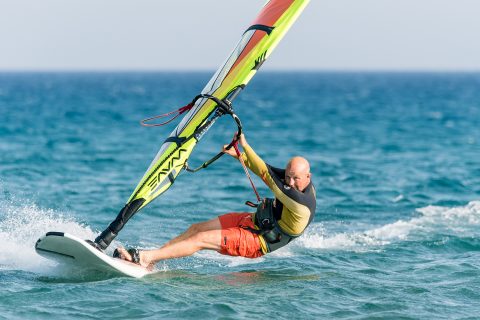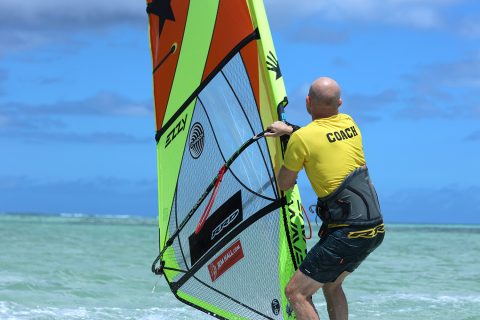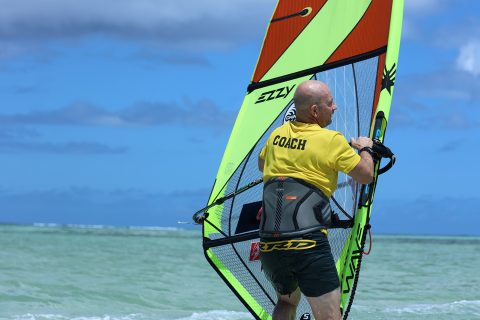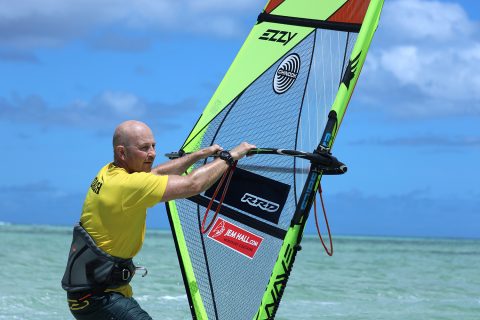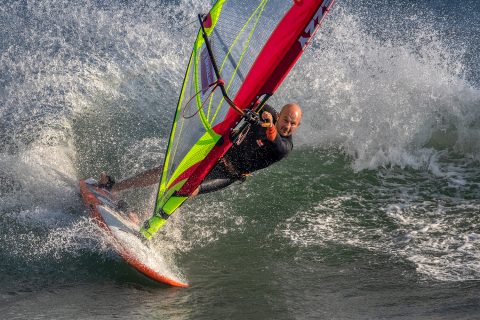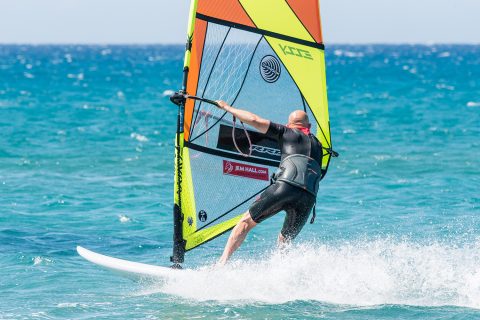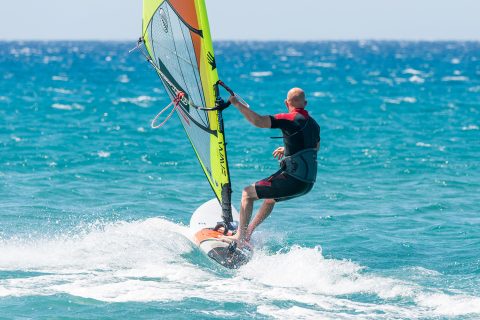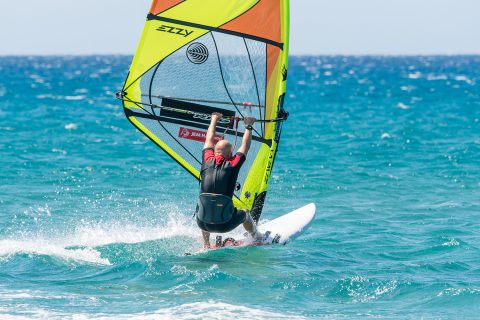JEM HALL
MOVE ON UP – WINDSURFING TECHNIQUE
HANDY HINTS
From our June 2022 issue of Windsurf Magazine, our technique guru Jem Hall explains where to best postion your hands on the boom for common moves.
PHOTOS – Radical Sports Tobago, Clark Merritt, Eye Sea You Photo.
This month we look at the importance of where our hands are placed on the boom, and when and where they can slide to for optimal performance through common moves. Well positioned hands give our starts (beach and water) a boost, get us planing earlier, enhance our speed, and furthermore, they help make transitions more fluid, successful and consistent.
Hand hangover
Hands end up poorly positioned on the boom for a variety of reasons; here are my proposals as to why.
- Beginner days: when you first learn to windsurf, your instructor needs to be very diligent to ensure your hands are in the right place on the boom, i.e. around the power point and about shoulder width apart. Bad habits can form early, if not corrected and hands end up too far forwards on the boom, and possibly too far apart too.
- Early harness use: in a rush to tick off a key progression pathway in our sport you may have donned a harness too early, and while this can mean you can hold the power with your hips and legs, it can inhibit your discovery of where your hands should be. I believe we should spend more time in lighter or medium winds unhooked, or even harness off, to help build a ‘feeling’ for the rig and also our strength and endurance.
- Line length: shorter harness lines mean you can only place your hands wide apart, and the most damaging position is the front hand being too far forwards. Longer lines open the possibility of your hands being closer together, as you can drop your hips and distance yourself from the sail. This will then enhance your ability to produce more power from the rig, as it can then be more upright and in effect, ‘catching more wind’.
- Beach starts: how you start is how you go on. If your hands are always wide apart in your stance, then you will most likely beach start and waterstart like this. People will then rarely move their hands into a better position once under way.
Time to slide
Now that you understand the ‘hand’ hangovers that may arise, let me rid you of those and get you moving in the right direction as we examine how to position your hands better.
- Narrow and wide: for you to believe, and feel, how your hands can be in a better position, sail along non-planing or planing, and move your hands wider and then narrower. Then try to get planing with your hands wide and then narrow. The results will be obvious and enlightening.
- Bareback: in light winds, or even medium planing wind, sail without a harness for a few runs and again try moving your hands around on the boom to find where they should be for maximum power. This will inevitably get you to have to control more power and thereby use your hips more effectively to counterbalance the power.
- Shift and slide: in the above exercises you will start to pull down on the hand you are not moving, which will then free up the hand you wish to move. You are shifting load, through pulling down on this hand more, to one hand, and then you can slide the other hand.
- Pull down and slide: the easiest way to feel how effective this is, is to load one hand and then shift the other in your gybe preparation. Whilst hooked in, and getting down ‘James Brown’, pull down hard on your front arm and then with your back arm free, it can move back.
- Shift and slide to gybe: coming out of a gybe clew first, if we want to rotate the rig efficiently then we must slide the mast hand from proximal to the front harness line, to all the way to the front of the boom. Do this by pulling down on the clew hand, this will give you control AND lighten the load on the mast hand, and then sliding the mast hand is way easier and your rig rotations will be super slick.
- Throw and slide in the tack: as you transition in the tack you reach for the new side of the boom (at the front of it), as you then switch the feet and step back, look forwards fast and throw the rig forwards fast and slightly release your grip on this front hand so the boom slips through your fingers and your front hand ends up next to the front harness line. Thereby optimally placed to get the rig upright so it can catch wind and produce power to not only steer out, but also then get planing.
- Slippery hands: there are many times when your hands need to move up and down the boom fast, and for this to happen you must lighten your grip. This is perhaps most evident in wave riding and gybing, so get into a lighter grip on the boom as early in the sport as possible to boast your progression. Try to put the rig in your finger tips more, not the palms of your hand, and see your hands as hooks, not grips.
- Sliding the hand ensures a slick rig flip, so let’s get those hands moving. Photo by Eye Sea You Photo.
- Narrower hands helps us to keep speed with less power, keeping the rig upright and ensuring our back hand does not oversheet. Photo by Eye Sea You Photo.
Brilliant basics
Now you understand where your hands should be on the boom, and also how you can move them to re-position, I will give you some good habits to move forward with:
- Start: if we start how we mean to go on, then having our hands at the power point will mean we arrive on the board in a great position to get speed. Therefore ensure your hands are relatively back on the boom to steer and then get up and away in your starts. Take this further by aiming to plane out of your beach/water starts when windy. Correctly positioned hands will actually help you ‘get up’ faster and more often.
- Narrow or wide: I have been mainly extolling the virtues of narrower hands (shoulder width on the boom), and whilst this is great for early planing, speed with less sail power, better starts and going upwind, there is also a time to widen your grip on the boom. The front hand can move forward a few cms, as can the back one, and this, accompanied by dropping your elbows, will yield more control when you are dealing with more power, like when overpowered for instance.
- Behaviour breeds behaviour: one of my most used coaching mantras is, ‘back, back, back’ for gybing. This means get the front hand back, because this will then help you get your back hand back, and the last back is, more often than not, get your back foot back.
- Back hand back: I ask on every clinic what is the most important action in the gybe, and thereby too the forward loop and bottom turn? A string of answers will then come, like get speed, carve hard, and lean forward. The actual answer is back hand back (BHB)!
- Old back hand reaches over and round to new side of the boom, just before the foot change.
- Head switches to see new direction to assist throwing rig forward to catch the wind and steer out as feet are stepping back.
- As the rig is thrown forward the mast / front hand can then slip down the boom to its best placed position.
Drills
I have presented how well placed hands can help you perform, and how to move them. Now let’s take it further and really make your hands fluid by doing these drills:
- Dry gybe: This in the Carve Gybe Preparation chapter of my Beginner to Winner DVD. It is essentially gybing your board and rig whilst standing in waist depth water with rig steering and then ending up in the new direction clew first. From here you can you really improve your clew first control and understand it better, after this you then slide your closest to the ‘mast’ hand towards the mast, from its original strong clew first position proximal to the harness line, right to the front of the boom, where it is best placed to rotate the rig fluidly. It is an amazing drill and really helps you feel your hands slide, and all from a low position underneath the rig, with no chance of falling in as you are in effect walking around on the bottom as you gybe. Remember to look at the clew mid gybe and then look forward throughout the rig rotation.
- Steering non-planing: on a floaty board and smaller sail, steer down and upwind. Steer downwind, sliding your back hand down the boom, with plenty of leg scissoring. As you reach downwind, then look back upwind, slide your back hand up to the harness line and scissor back upwind. Aim for really big changes in direction. This is also a fab drill for feeling what your hands do when wave riding.
- Preparation only: with plenty of speed, and space, across the wind, slide your back hand back, as you would for a carve gybe, unhook and keep speed. Then hook back in and slide your back hand back up the boom and keep sailing across the wind. Try it 1x every run and then tack at each end. This is awesome for your gybes and all gybe preparation.
- One-handed sailing: ironically with one hand off the boom (whilst hooked in) your hips have to be more reactive, and are tasked with either controlling or producing power with more alacrity. Furthermore, your feet must also take care of steering the board more. Having improved skills in both of these will then mean you are more able to move your hands with ease. This drill is hands down THE best way to improve your stance.
Kit:
- Hands together in the top turn gets the rig forward, away and sheeted out so the board can be banked and spray can then be sent. Photo by Clark Merritt.
Generous straps to allow weight changes to either the ball or heel of your foot. As a simplification you can then widen your grip and weight your heels in a gust or narrow your grip and weight the ball of your feet in a lull.
Long lines enable you to get lower, move your hips and thereby pull down more on the boom so your hands can move. Especially in the preparation phase of transitions.
- With back hand well back, open the sail to see your exit and be ready for the foot change.
- The lighter load on the front hand (mast hand), means it can slide to the front of the boom so the rig rotation is fluid and the body can stay outboards so the board can be carved out on your heels.
- New front hand then drives the rig forward and the boom can slip through the fingers to let this hand reach a position, next to the front harness line, where the rig is best placed to give a smooth transition to gaining speed and then planing.
Ezzy sails, RRD (boards, wetsuits & softwear), Chinook & Black Project fins sponsor Jem Hall. Get him live and direct on one of his highly acclaimed coaching holidays – check out his website www.jemhall.com for details. You can also follow him on twitter / Facebook / Instagram.

